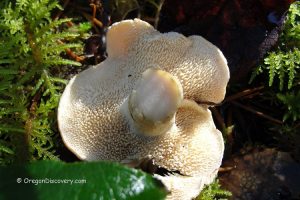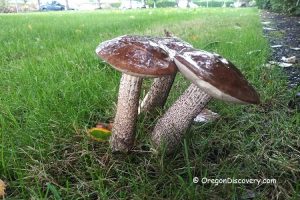
• White Matsutake is highly prized for its spicy cinnamon aroma and unique flavor
• Matsutake is most abundant in coastal woods and the southern Cascade Range
White Matsutake (Tricholoma magnivelare) or Pine Mushroom is highly prized for its spicy cinnamon aroma and unique flavor. The most valuable and expensive fungi in Japan, Armillaria Matsutake costs up to $500 per pound.
The Pacific Northwest matsutake resembles Japanese species though it tends to have a bit different color and texture. In North America, the matsutake (Armillaria ponderosa) is harvested commercially for the local market and export to Japan.
White Matsutake is widespread in British Columbia, Washington, Oregon, and Northern California, fruiting on the ground, in sandy soil under pine, hemlock, Douglas fir, madrone, tanoak, and manzanita.
Before heading into the woods to harvest the matsutake, check rules and regulations for this particular area. Obtain a commercial or a personal use permit. A non-commercial permit is required in some areas including the national forests.
Up to six Matsutakes per day can be collected for incidental and non-commercial use in the Siuslaw National Forest. Mushrooms collected under incidental use must be cut in half length-wise immediately after picking.
Mushrooms harvesting is illegal in national parks and national forest wilderness.
Oregon Mushroom Picking Regulations
Caution. Do not confuse White Matsutake with White Amanita that has a bulb or volva at the steam's base.
Cap: Firm, wide, convex becoming flat with age, white to yellowish, 2-8 inches (5-20 cm) wide.
Cap's Underside: White gills when fresh, stains brownish with age.
Veil: Partial veil is present, covering the gills of the young mushrooms, forming a soft ring on the stalk with age.
Spores & Print: Elliptical to round, colorless.
Stem: Thick, fibrous, tapers to a point at the base without an amanita-like bulb, 2-6 inches (5-15 cm) long.
Flesh: Firm, white.
Habitat: Sandy soil on the ground under conifer trees.
Season: August-November.
Features: Distinctive spicy cinnamon odor.
Where and When to Find White Matsutake in Oregon
In Oregon, matsutake is most abundant in coastal woods and the southern Cascade Range. Also, these fungi are found in the Willamette, Umpqua, Deschutes, and Fremont-Winema National Forests.
Mushrooms are usually hidden among moss, leaf, and plant litter on the forest floor; so, look carefully.
Cascade Range
White Matsutake is found on both east and west sides of the Cascade Range at elevations from 1,000 to 4,500 feet (300-1,300 m) above sea level in mixed conifer forests with ericaceous shrubs. These fungi associates with Douglas-fir, western hemlock, western white pine, and Ponderosa pine. Sugarstick (Allotropa virgata) and matsutake mushrooms form symbiotic relationships, so this plant from Ericaceae family is a great indicator to check the area around.
Matsutake is common in the southeastern Cascade Range including the Diamond Lake Ranger District of the Umpqua National Forest, the Crescent Ranger District of the Deschutes National Forest, the Chemult Ranger District of the Winema National Forest, the Goosenest Ranger District of the Klamath National Forest, and the McCloud Ranger District of the Shasta-Trinity National Forest.
Matsutake fruits in the Klamath Mountains of southwestern Oregon and northern California.
Oregon Coast and Sand Dunes
Matsutakes are found occasionally along the northern part of the Oregon Coast and, usually, are associated with shore pine trees.
Central and southern coastal forests offer better foraging opportunities. King Boletes, Matsutakes, and Lobsters are common in a forested part of Oregon's coastal sand dunes. Matsutakes are found on naturally stabilized dune platforms at elevations between 3 and 300 feet (10-100 m) above sea level among shore pines, Sitka spruce and western hemlock, manzanita trees, bushes of salal, evergreen huckleberry, and Pacific rhododendron.
The season typically continues from September to November. The first mushrooms come up in conifer forests at the higher elevation. Later, Matsutake can be found in forest areas at the lower elevation and along the Oregon Coast.
Picking Requirements
Improper picking techniques can destroy Matsutake mushroom habitat. Three simple steps will ensure the future crops of Matsutake.
Locate Matsutake by watching for small bumps in the duff or litter layer. Carefully clear the duff off the mushroom to get a good idea of where the base is may be necessary. Searching by raking the duff can ruin the mushroom and destroy the mycelium, don't do it! Damaged mushroom stems or caps have little or no value.
Extract the mushroom by inserting a knife under the base prying up and out of the ground. Damage can be minimized by prying straight up. Remove any dirt now with the mushroom upright to keep the gills clean. Using a narrow knife will reduce damage to the mycelium ensuring a future crop, maybe as soon as three or four days later. Protect the mycelium by replacing the soil and duff, patting firmly on this place.
Methods of Cooking
Methods of cooking include stir-frying, sautéing, drying, pickling, preserving, and freezing. Roasting or grilling is a great approach to save unique pungent aroma and flavor.
White Matsutake Grilling (1 lb /450 g)
- Clean mushrooms from the soil with a brush and water, trim and discard the base of the steam
- Slice up the caps and stalks and place them in a bowl
- Combine it with 1 garlic clove, finely grated
- Sprinkle with sea salt pepper to taste
- Add 2 tablespoons of olive oil and toss to coat evenly
- Place your sliced mushrooms in the center of the foil packet
- Grill over medium-high heat for 12 to 15 minutes or until mushrooms are tender, turning packet over halfway through cook time.
You May Also Enjoy
Disclaimer
This is not an official guide to wild mushroom foraging. Please, do your own research, be sure to practice with a mushroom expert before you pick up and consume any wild mushrooms. Before you start wild mushroom harvesting, learn to accurately identify poisonous mushrooms as well. All wild edible mushrooms must be thoroughly cooked. Make sure that you are not allergic to a new mushroom by trying a small amount before eating more.












